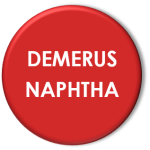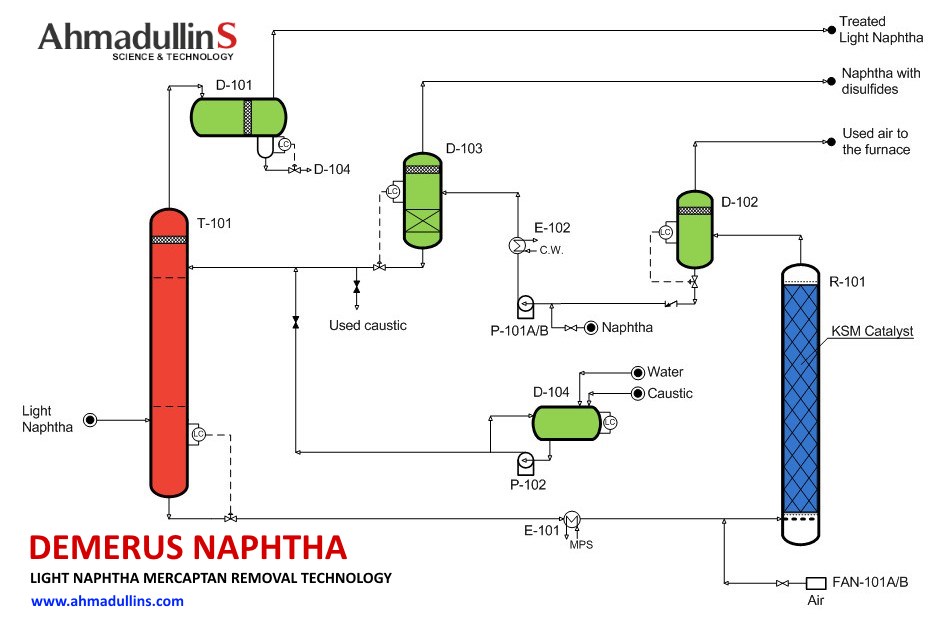 LIGHT NAPHTHA MERCAPTAN REMOVAL TECHNOLOGY
LIGHT NAPHTHA MERCAPTAN REMOVAL TECHNOLOGY
«DEMERUS NAPHTHA» process
Application area
This technology is designed for high-octane gasoline distillates sweetening in which the total sulfur content without taking into account mercaptan sulfur does not exceed Euro 4 standards.
Assignment
Mercaptan removal from LN by alkaline extractive treatment in the presence of heterogeneous KSM-X catalyst.
DEMERUS NAPTHA is used for mercaptan sulfur removal from light naphtha (LN) to residual content not more than 10.0 ppm and total sulfur content not exceeding 50.0 ppm.
LN is supplied to the bottom of extractor T-101. Regenerated aqueous NaOH solution is supplied to the top of T-101 from tank D-103 for sodium mercaptide extraction according to reversible reaction (1):
RSH + NaOH = RSNa + H2O (1)
Mercaptans free LN removed from T-101 and settled in D-101, is fed to gasoline blending.
Mercaptans free LN removed from T-101 and settled in D-101 is further fed to gasoline blending.
Alkaline solution saturated with mercaptides is removed from the bottom of T-101 and through heat exchanger E-101, where it is heated to 60°C, it is fed to the bottom of R-101. Estimated amount of air at pressure of 0.5 MPa is also supplied to the bottom of R-101. In R-101 on the surface of KSM-X catalyst alkali regeneration proceeds by reactions (2) and (3):
2RSNa + 0.5 O2 + H2O → RSSR + 2NaOH (2)
2RSNa + 1.5 O2 + H2O → RSО2SR+ 2NaOH (3)
The mixture of exhaust air, regenerated alkaline solution and formed disulfides and alkylthiosulphonates from the top of R-101 is fed to separator D-102. Air is removed from the top of D-102 through an entrainment separator and is directed to the furnace for combustion.
Regenerated alkaline solution with dissolved disulfides and alkylthiosulphonates is removed from the bottom of D-102 mixed with gasoline fraction by pump P-101A/B, cooled down to 40°C in cooler E-102 and then fed to disulfides separator D-103.
Gasoline fraction saturated with disulfides is removed from the top of D‑103, and mixed with feed of any of the units: FCC, atmospheric distillation or hydrotreating unit. Regenerated alkaline solution from the bottom of D-103 is returned to T-101 to remove mercaptan compounds from LN.
Advantages
DEMERUS NAPHTHA allows reducing the load on distillate fractions hydrotreating unit.
Alkaline solution operation term is extended up to 1 year without replacement. This significantly reduces the consumption of alkali and the amount of alkaline wastes.
KSM-X catalyst used in DEMERUS NAPHTA process provides strong retention of catalytically active components, improved resistance to catalyst poisons and thermal stresses, stable activity during the whole commercial operation term. No need for its periodical or continuous feed with expensive variable valence metal compounds. It prevents cobalt phthalocyanines and derivatives, as well as salts of other heavy metals getting into wastewater. Guaranteed lifetime of the catalyst is 8 years.
Alkaline solution operation term extended up to 1 year without replacement. This significantly reduces the consumption of alkali and the amount of alkaline wastes. KSM catalyst provides strong retention of catalytically active components, improved resistance to catalyst poisons and thermal stresses, stable activity over the life of commercial operation. No need for its batch or continuous feeding with expensive variable valence metal compounds, this eliminates of cobalt phthalocyanines and derivatives, as well as salts of other heavy metals getting into wastewater. Guaranteed lifetime of the catalyst is 8 years.





